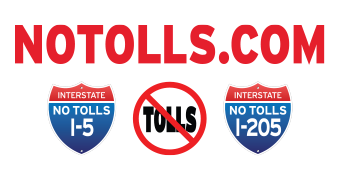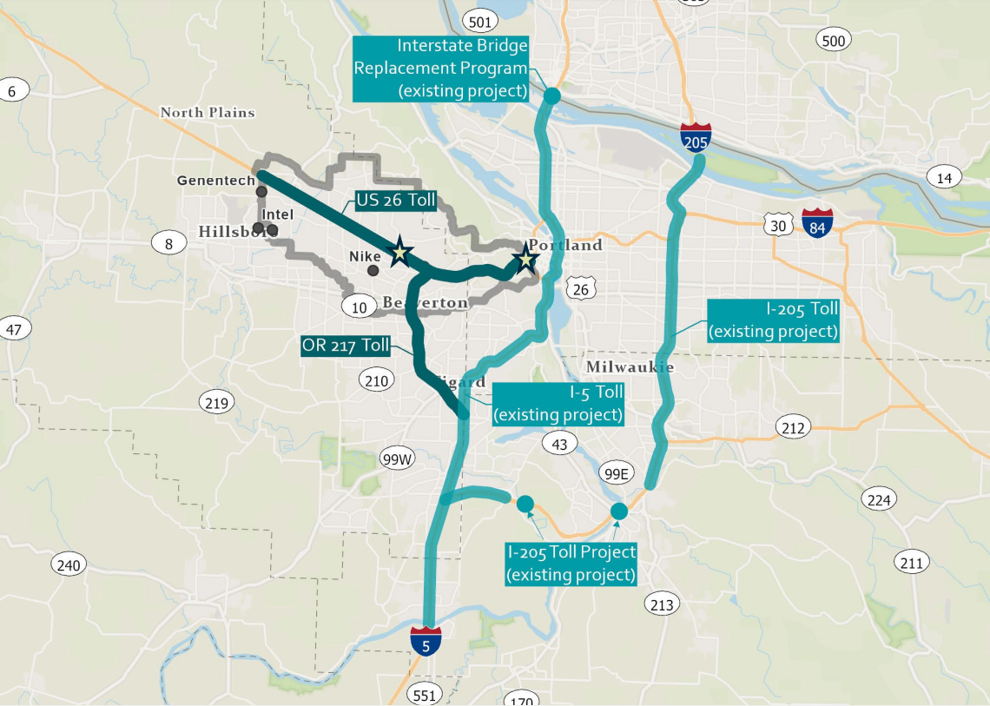Bridge tolls would begin in April 2026 during construction and run for 35 to 40 years
Monday, February 26, 2024
By John Ley
for Clark County Today
Six years ago, the Oregon Department of Transportation (ODOT) created a “Value Pricing” Policy Advisory Committee (PAC) to discuss tolling issues and allow for public input. That process was labeled “a sham” by Clark County Councilor Eileen Quiring O’Brien. During the process, it was revealed that Clark County residents made the largest number of comments and input efforts to an ODOT community survey about tolling, with 47 percent of responses. That tolling would begin “at the border” with Washington, per Oregon legislature direction in HB 2017.
On Friday, a subcommittee of the Washington and Oregon Transportation Commissions (WSTC & OTC) met for the first time. The members’ mission is to discuss and begin the process for imposing tolls on the Interstate 5 Bridge. The Interstate Bridge Replacement Program (IBR) finance plan calls for $1.2 billion to $1.5 billion in toll revenue to be contributed towards the project. Recently, IBR Administrator Greg Johnson informed legislators from both states the cost will go up, with details to be released later this year.
The four-member committee is composed of Roy Jennings and Jim Restucci from the Washington State Transportation Commission (WSTC) and Lee Beyer and Alicia Chapman from the Oregon Transportation Commission (OTC). They will set “pre-completion” tolling rates which are expected to begin in April 2026, and then different rates once construction of the IBR is complete, supposedly in 2033. The committee members will make recommendations they hope will be adopted by each state’s transportation commission.
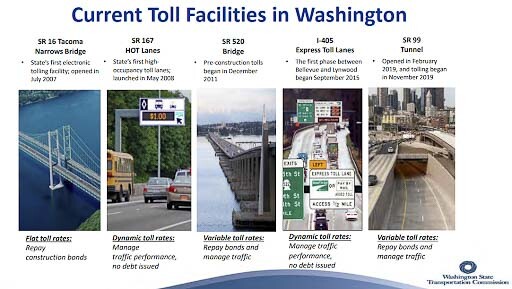
This is of extreme interest to Clark County and Southwest Washington residents as over 80,000 earn a paycheck in Oregon. During the failed Columbia River Crossing (CRC) effort over a decade ago, it was estimated Southwest Washington residents would be paying 60 percent or more of the tolls. A year ago, Portland economist Joe Cortright estimated daily round trip tolls from Vancouver to Wilsonville could run $28 to $31.
Oregon officials plan two separate tolls. One would be a bridge or “facility” toll on the Interstate Bridge and Boone Bridge on I-5, and the Abernethy and Tualatin River bridges on I-205. The second toll is a “per mile” toll for congestion pricing. They intend to have variable rate congestion pricing tolls on all Portland area highways including I-84, I-5, I-205, I-405, and highways 26 and 217 in Washington County. This is part of their Regional Mobility Pricing Program (RMPP).
Last fall, the WSTC approved a 50-percent increase in maximum toll rates on I-405 and SR-167 in the Puget Sound to $15 per segment, during congested periods. With this corridor cut into three segments, a driver could be paying up to $90 per day for a single round trip and potentially over $20,000 per year. The new toll rates begin March 1st.
Four of Washington’s toll facilities have variable rate tolls which charge higher prices when traffic is most congested. The IBR team reports they expect half of all rush hour traffic to be traveling zero to 20 miles per hour by 2045, indicating maximum tolls will be charged during a major portion of the day. Additionally, the IBR expects morning travel times will double to 60 minutes when going from Salmon Creek to the Fremont Bridge in Portland. The higher the congestion, the more drivers will be charged.
The rates initially under evaluation are a minimum rate of $1.50 or $2.15, when roads were not congested. The maximum rate for using the bridge is $3.15 and $3.55 in 2026 dollars. There would be a 2.15 percent annual increase in toll rates.
Staff evaluated seven toll rate scenarios initially, and are studying an additional four scenarios requested by the committee. All tolling would start on the Interstate Bridge once construction begins in 2026. The initial suggestion is there would be no tolls charged for overnight use of the bridge from 11 p.m. to 5 a.m. during bridge construction.
Under consideration is a low income toll program. It would offer a 50-percent reduction for low income individuals, defined as 200 percent of the federal poverty level (FPL). That presently equates to a family of four making about $60,000. They are also considering an additional reduction program for those making up to 400 percent of the federal poverty level. No other state offers a discount to that high of the FPL. Native American Tribes are seeking to be exempted from all tolling, according to Steve Barnett of the Cowlitz Tribe.
Five of the initial seven tolling scenarios had no low income toll program. One provided a 50-percent reduction and the other offered a 25-percent reduction. The four added options all contained a 50-percent low income toll reduction. Any loss of tolling revenue for the low income program would have to be made up by charging higher prices for others.
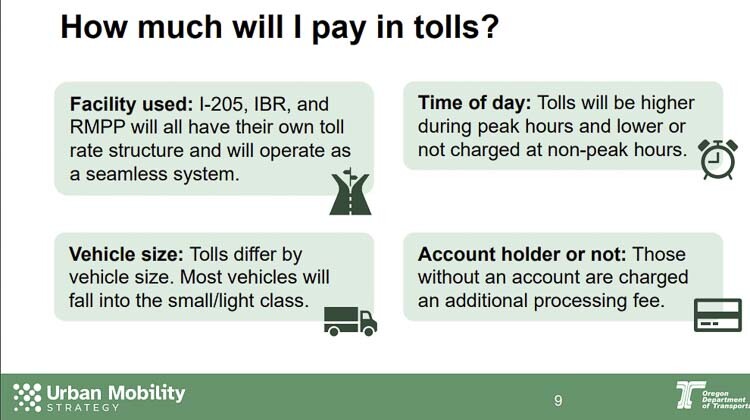
Freight haulers would be paying 2 to 4 times the toll rates in the initial scenarios, and 1.5 to 2 times the normal car rate in the added four scenarios. Recently the Oregon Trucking Association (OTA) sued the state alleging they have been paying more than their fair share of transportation taxes in Oregon.
But citizens need to understand the tolls discussed by this body are simply for the Interstate Bridge. Oregon is moving forward with their Regional Mobility Pricing Program (RMPP) which will charge a “per mile” road use toll on area freeways. It was the combination of facility tolls for the I-205 bridges or tolls for the I-5 bridges added to the RMPP tolls, that brought Cortright’s total round trip tolls up to the $28-$31 per day range.
It was recently revealed that ODOT plans to spend $261 million to implement their tolling system. Furthermore, West Linn Mayor Rory Bialostosky shared that ODOT expects an 83-86 percent cost of collection for I-205 tolls. This far exceeds the 35 to 68 percent cost of collection on I-405 in Seattle. The maximum toll rate revealed by Bialostosky was $5.60 for crossing the Abernethy Bridge.
In the enabling legislation to collect tolls on the Interstate Bridge, the Washington State Legislature prohibited Oregon from collecting tolls on the I-205 bridge. That will trigger significant traffic diversion as more people use the free I-205 Glenn Jackson Bridge to get into Oregon. Cortright has estimated 30,000 vehicle diversions to I-205, adding to the traffic jam on that bridge and freeway system. The IBR team has already admitted the I-205 bridge is at capacity during peak periods.
It was mentioned by staff that they expect a Finding of No Significant Impact (FONSI) from the NEPA environmental review, later this year. The commissioners are worried about significant impacts to low and middle income families, seemingly contradicting the expectation of receiving a FONSI from the government.
Two of the tolling scenarios predicted that with no low income tolling program, there would be a 5 to 9 percent increase in vehicle traffic on I-5. Other options show either flat traffic numbers or up to a 5 percent decrease in traffic. The IBR is predicting a significant increase in the number of vehicles by 2045, a decade after construction is complete.
IBR financial consultant Brent Baker indicated they do not expect to borrow the $1.24 billion (or more) until the end of this decade. At that point they expect the tolls would be used to pay off borrowed funds for 35 to 40 years. Initial rates will be established this summer, with Transportation Commissions giving final approval in the summer of 2025.
Baker mentioned that tolls must be reduced (not eliminated) after paying off construction. The tolls serve two functions – manage congestion and funding highway (bridge) construction.
The Washington State Legislature provided the following direction in 2023 on the setting of toll rates and exemptions.
- May not be set at a rate that exceeds the highest toll rate allowed on any of the other toll facilities in Washington.
- May not be set to pay for all of the operational and administrative costs of Oregon’s tolling system.
- Must require toll rates specifically cover the I-5 Columbia River Bridge without subsidizing other Oregon toll facilities
A level 2 tolling analysis was completed in November 2023. The final, level 3 analysis for Wall Street will take 6-9 months. Yet a timeline graphic shows the study beginning in the second half of 2024 and going through all of 2025.
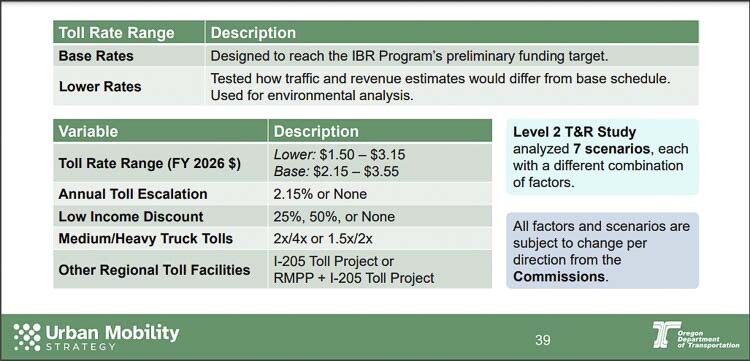
During public comment, citizen John McCabe expressed concerns about traffic diversion to I-84 and Marine Drive when people use I-205. He also was concerned that because state law says these tolls can’t exceed any others in the state, it might trigger additional increases on other Washington tolling facilities.
There was no mention of the fact that Oregon citizens are collecting signatures for IP-4 to guarantee a Vote Before Tolls can be put on any Oregon highway. IP-4 is retroactive to 2017 and would include the Interstate Bridge.
The next two meetings of the committee are March 15 and April 19.
